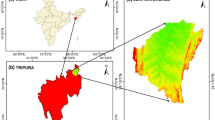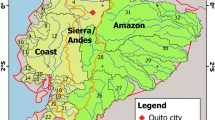Abstract
The major uncertainty in soil erosion assessment studies is derived from LS-factor constituting slope length and slope steepness factors. Empirical soil erosion models employing different algorithms for estimation of LS-factor using raster-based digital elevation models (DEMs). Different algorithms have been adopted for LS-factor determination in soil erosion studies without proper justification for their selection according to the terrain characteristics; a few among them addressed suitability of the algorithms on hilly terrains. The present study focused on the performance of LS-factor estimation methods involving specific contributing area (SCA) method and cumulative slope length method for slope length factor and USLE, RUSLE and USPED algorithms for slope steepness factor in a gently slo** terrain. The results showed that SCA method is the best performing method in gently slo** terrain since the effect of contour length exponent get minimized since there are less influence from diagonal flow direction. The pixel-to-pixel-based slope length exponent may result in more appropriate estimation of slope length factor in gently slo** terrains. The SCA-based slope length estimation along with USLE S-factor algorithm was found to perform well under different elevation classes and slope classes in both SRTM DEM and ASTER DEM. The results from the study may be helpful in appropriate prediction of soil erosion in gently slo** terrains.







Similar content being viewed by others

References
Abdul Rahaman, S., Aruchamy, S., Jegankumar, R., & Abdul Ajeez, S. (2015). Estimation of annual average soil loss based on RUSLE in Kallar watershed, Bhavani basin, Tamil Nadu, India. ISPRA Annuals of the Photogrammetry, Remote Sensing and Spatial Information Sciences, 2(2), 207–214.
Desmet, P. J., & Govers, G. (1996). A GIS procedure for automatically calculating the USLE LS factor on topographically complex landscape units. Journal of Soil and Water Conservation, 51(1), 427–433.
Hickey, R. (2000). Slope angle and slope length solutions for GIS. Cartography, 29(1), 1–8. https://doi.org/10.1080/00690805.2000.9714334.
McCool, D. K., Brown, L. C., Foster, G. R., Mutchler, C. K., & Meyer, L. D. (1987). Revised slope steepness factor for the universal soil loss equation. Transactions of the ASAE, 30(5), 1387–1396. https://doi.org/10.13031/2013.30576.
Mitasova, H., Hofierka, J., Zlocha, M., & Iverson, L. R. (1996). Modelling topographic potential for erosion and deposition using GIS. Journal of Geographical Information Science, 10(5), 629–641. https://doi.org/10.1080/02693799608902101.
Mulengera, M. K. (2008). An equation for estimating the (R) USLE slope steepness factors. Tanzania Journal of Engineering and Technology, 2(2), 95–100.
Musgrave, G. W. (1947). The quantitative evaluation of factors in water erosion: A first approximation. Journal Soil and Water Conservation, 2, 133–138.
Ouyng, Da, & Bartholic, Jon. (2001). Web-based GIS application for soil erosion prediction, Honolulu, USA.
Smith, D. D., & Whitt, D. (1948). Estimating soil losses from field areas of claypan soil. Soil Science Society of America Journal, 12, 485–490.
Tirkey, Anamika Shalini, Pandey, A. C., & Nathawat, M. S. (2013). Use of high-resolution satellite data, GIS and NRSC-CN Technique for the estimation of rainfall-induced runoff in small catchment of Jharkhand India. Geocarto International, 29(7), 778–791. https://doi.org/10.1080/10106049.2013.841773.
Vikhe, S. D., & Patil, K. A. (2016). Assessment of Soil Erosion in Sukhana Basin using USLE, GIS and remote sensing: A case study. International Journal of Civil, Structural, Environmental and Infrastructure Engineering Research and Development, 6(4), 71–78.
Wang, G., Gertner, G., Parysow, P., & Anderson, A. (2001). Spatial prediction and uncertainty assessment of topographic factor for revised universal soil loss equation using digital elevation models. ISPRS Journal of Photogrammetry and Remote Sensing, 56, 65–80. https://doi.org/10.1016/S0924-2716(01)00035-1.
Wischmeier, W. H., & Smith, D. D. (1965). Predicting rainfall erosion losses from cropland east of the Rocky Mountains-Guide for selection of practices for soil and water conservation. Washington DC: U. S Department of Agriculture, Agricultural Handbook No. 282.
Wischmeier, W. H., & Smith, D. D. (1978). Predicting rainfall erosion losses: A guide to conservation planning. Washington DC: US Department of Agriculture, Agricultural Handbook No. 537.
Author information
Authors and Affiliations
Corresponding author
Additional information
Publisher's Note
Springer Nature remains neutral with regard to jurisdictional claims in published maps and institutional affiliations.
About this article
Cite this article
Anjitha Krishna, P.R., Lalitha, R., Shanmugasundaram, K. et al. Assessment of Topographical Factor (LS-Factor) Estimation Procedures in a Gently Slo** Terrain. J Indian Soc Remote Sens 47, 1031–1039 (2019). https://doi.org/10.1007/s12524-019-00953-3
Received:
Accepted:
Published:
Issue Date:
DOI: https://doi.org/10.1007/s12524-019-00953-3



